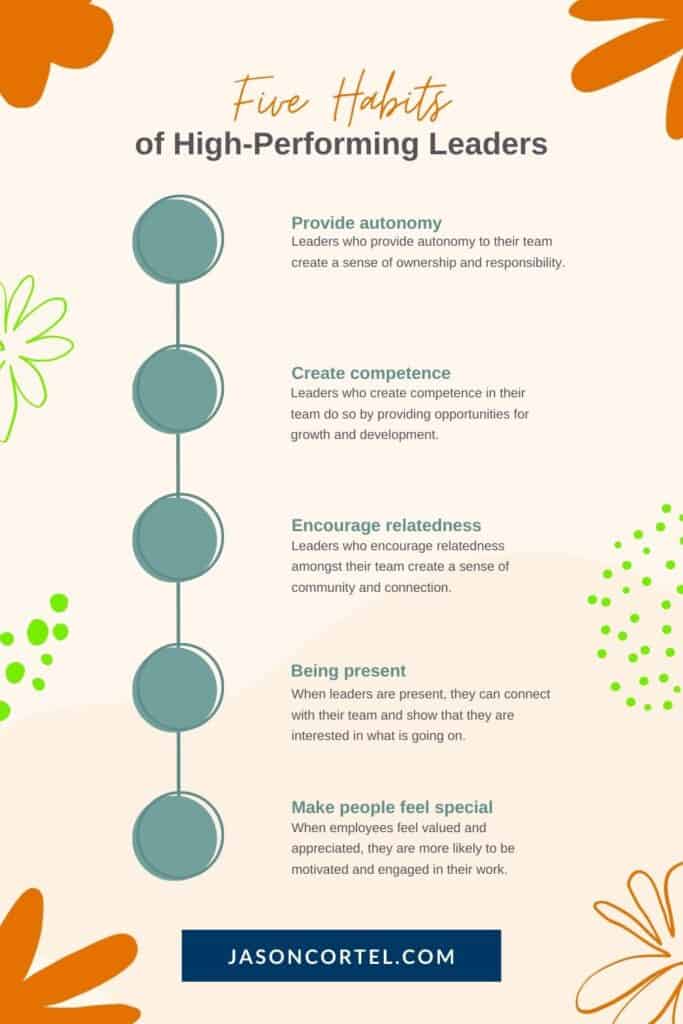People always ask me how I do what I do. They want to know how I’ve created high-performing teams, created strong office cultures, and developed high-performing leaders. However, extraordinary workplace cultures and high-performing teams don’t just happen. They result from intentional leaders who develop habits that create psychological safety and a focus on workplace well-being.
This blog post will discuss the five habits of extraordinary leaders that create high-performing teams. These habits create a sense of psychological safety, developing a workplace culture that supports productivity, inclusion, and more!
Provide autonomy
Leaders who provide autonomy to their team create a sense of ownership and responsibility. When team members feel like they are in control of their work, they are more likely to take pride in their work and be invested in the team’s success. High-performing leaders provide autonomy because it helps their team develop skills and grow as individuals. When team members can use their strengths and talents, they are more likely to be productive and feel fulfilled in their work.
High-performing leaders provide autonomy to their employees by giving them control over their work. Leaders can do this by delegating tasks and providing team members with the resources they need to complete their work. Additionally, leaders can encourage employees to contribute their own ideas and solutions to problems. When team members feel like they are a part of the solution, they are more likely to be invested in the outcome.
High-performing leaders who provide autonomy allow employees to make mistakes and learn from them. This will enable employees to take risks and grow as individuals.
Create competence
High-performing leaders create competence in their team by providing opportunities for growth and development. They help their team members learn new skills and use their strengths and talents. Leaders who create competence also emphasize high standards and quality work. This helps team members feel confident in their abilities and strive for excellence. Team members who feel competent and challenged are more likely to be productive and engaged in their work.
High-performing leaders help employees feel competent by providing coaching, training, and development opportunities. Leaders can also help employees develop a sense of mastery by giving them challenging tasks and responsibilities. Additionally, leaders can set high standards and hold employees accountable for meeting them. When team members feel like they are constantly mastering their craft, they are happier and more engaged in their work.
Encourage relatedness
High-performing leaders encourage relatedness amongst their team because it creates a sense of community and connection. This helps team members to feel supported and valued. Leaders who encourage relatedness also help their teams to develop relationships with one another. When team members feel connected to one another, they are more likely to be supportive and helpful. This can contribute to a positive work environment and a high-performing team.
Additionally, high-performing leaders create relatedness to the organization’s mission by helping employees feel connected to the values and goals. They do this by emphasizing the importance of the mission and communicating the organization’s values to their team. Leaders who create relatedness also help employees feel like they are a part of something bigger than themselves. This can encourage team members to work together towards a common goal and be more productive.
Being present
Leadership presence is important because it can help to create a high-performing team. When leaders are present, they can connect with their team and show that they are interested in what is going on. This can help to build trust and create a sense of psychological safety. Additionally, leadership presence can help to set the tone for the workplace culture. If leaders are positive and upbeat, it can help to create a positive work environment.
High-performing leaders demonstrate presence in several ways. One way is to be physically present in the workplace. Leaders should make an effort to be around their team and talk with them. This can help to build trust and show that the leader is interested in what is going on.
Additionally, leaders can be present through their actions. They should make sure that they are aware of what is happening and stay informed.
Leaders can also be present through their words. They should take the time to communicate with their team and ensure that everyone is on the same page.
Make people feel special
One of the most important things a leader can do is make their employees feel special. When employees feel valued and appreciated, they are more likely to be motivated and engaged in their work. Additionally, feeling special can help to increase job satisfaction and reduce stress levels. Finally, leaders who make their employees feel special are more likely to have high-performing teams.
There are many ways that high-performing leaders can make their employees feel special. One way is to show appreciation for their work. Leaders can thank employees for their contributions and let them know that their work is valued.
Additionally, leaders can give employees feedback and recognition. This can help employees feel like they are doing a good job and that their work matters.
High-performing leaders can also give employees opportunities to learn and grow. This can help employees feel like you are investing in their growth and development.
Lastly, high-performing leaders can create a positive work environment. High-performing leaders don’t tolerate bad behavior such as gossip, cliquishness, or other divisive attitudes. As a result, employees feel welcomed, appreciated, and supported.

High-performing leaders exhibit five main habits: proving autonomy, creating competence, encouraging relatedness, being present, and making people feel special. When leaders bring these habits to their team every day, they create a positive, healthy, and high-performing environment. I encourage you to focus on building these five habits of high-performing leaders.
Share your story about the best leader you worked for and what traits they exhibited that made them so memorable in the comments below.


